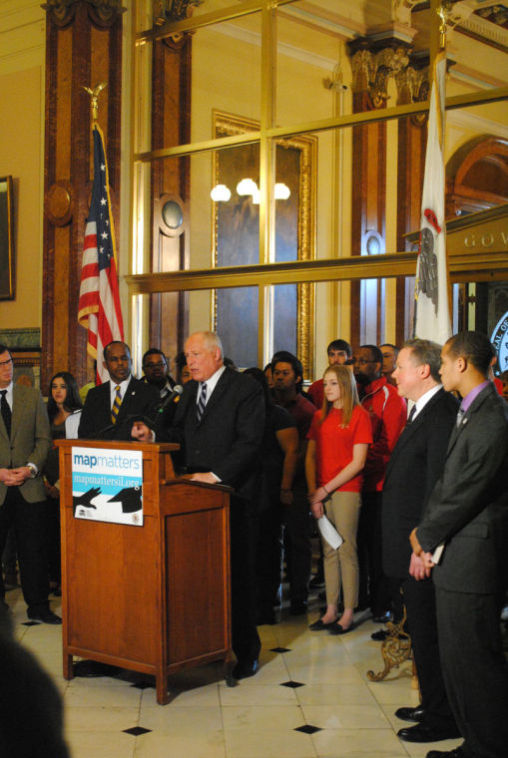Illinois students attend Gov. Quinn’s MAP rally
Gov. Pat Quinn speaks at the MAP Matters Day rally on Wednesday. Quinn has proposed to double MAP funding over the next five years.
May 1, 2014
Students from universities and colleges around the state were invited to come and voice their support for increased MAP grant funding at a rally Wednesday in Springfield, which was hosted by Gov. Pat Quinn.
Illini Democrats and the Illinois Student Senate both had representatives attend the MAP Matters Day rally to demonstrate their support for Quinn’s proposal to double MAP funding over the next five years.
Evan Keller, reporting director for Illini Democrats and freshman in LAS, emphasized the importance of the scholarship program.
“It’s going to greatly increase the number of first generation college students, which is completely in line with democratic philosophy and the philosophy of Illini Democrats,” Keller said. “We believe in mobility among classes, among people. And these people that have parents that don’t go to college, if they worked hard, and they’ve done well in school, they deserve just as equal a shot as kids with more money.”
Quinn visited the Illini Union a few weeks ago to discuss MAP funding and college affordability, where he was introduced by University President Robert Easter as “a great friend of the University of Illinois.”
Get The Daily Illini in your inbox!
Quinn plans to raise funding slightly for the University to $253.56 million in the 2015 fiscal year, assistant Illinois state budget director Abdon Pallasch said in an email.
He said that the “not recommended” budget — a scenario in which the temporary income tax hike would not be extended — would cut state public university funding by 12.45 percent.
David Blanchette, spokesman for Gov. Quinn, said that increased MAP grant funding could affect college affordability across the state.
“It could affect literally thousands of people’s ability to attend the University of Illinois at Urbana-Champaign,” Blanchette said. “I can’t stress enough how vital this is for people who want to attend college, but may not have the financial wherewithal to do so.”
Specifically in regards to MAP grants, Quinn’s budget proposal would increase funding for the program by $50 million. With this monetary increase, the University could fund about 1,750 more students with MAP grants, Pallasch said.
Jaclyn Gelfond, president of Illini Democrats and junior in LAS, attended the rally herself. She is a MAP grant recipient and she described the rally as energetic and optimistic.
“If anything, it only made me realize more so how important MAP grant funding really is,” Gelfond said in an email. “Students depend on these grants, and we are lucky to have a Governor that is fighting for them.”
She added that she heard personal stories about how MAP funding allowed students to attend college, including a first-generation student who attributed her opportunity to the scholarship program.
Former Student Body President Damani Bolden offered his support for the MAP rally as well.
“I am honored that the governor has called on our students to advocate for such a transformational program,” Bolden said in an email. “My administration is pleased to partner with Gov. Quinn to ensure that the funding increase in MAP grants becomes a reality.”
Pallasch commented that state funding of education has remained relatively constant over the past five years.
He also said that over the past few years, Quinn usually has proposed more funding for MAP grants then is appropriated by the legislature. Pallasch also spoke about the more general current state of education funding in Illinois.
“We do not spend at the foundation level,” Pallasch said. “We’re only at about 89 percent of what we should be right now spending in education. The proposal would correct that.”
To apply for a MAP grant, a student must fill out a FAFSA report. The grants are distributed to the students based on need with expected family contribution, cost of institution, and amount of other financial aid taken into consideration.
MAP grant recipients must be Illinois residents and enrolled in at least three hours at an approved Illinois college. Other requirements may be found on the Illinois Student Assistance Commission’s website.
Alex can be reached at [email protected].







